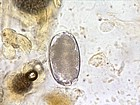Category:Strongyloidea
General Appearance
Strongyloid nematodes share a a number of morphological features. They are bursate, meaning that the males have a copulatory bursa. They are realtively short, typically 1 - 5mm, but stout in appearance with a large buccal capsule at the anterior end. The head or anterior also usually carries characteristic features such as teeth or cutting plates.
General Life-Cycle
The life cycle of the strongyloids is typical of most nematodes. The L3 to adult development occurs in the large intestine where the L3 larvae penetrate the mucosal wall and form nodules. Some strongyle species larvae, such as those of Strongylus edentatus and Strongylus equinus have a migratory life cycle in which they travel through body organs and can cause pathology before returning to the large intestine of the host.
Notable Species
Some species have been described in further detail and are linked above. Other species of some veterinary importance include Oesophagostomum columbianum which causes Peritonitis in sheep by penetration of intestines by larvae. Stephanuris dentatus causes peritonitis in pigs and may cause cysts in the pancreas
Pages in category "Strongyloidea"
The following 6 pages are in this category, out of 6 total.
